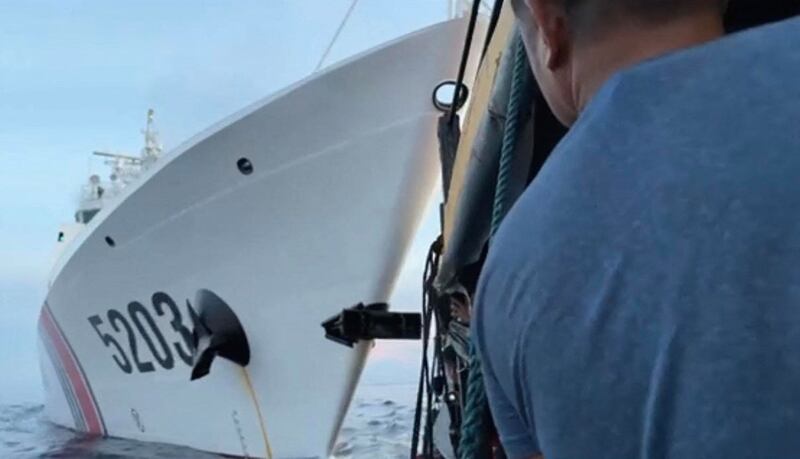Manila summoned the Chinese ambassador to the Philippines on Monday over two incidents in the South China Sea the previous day that analysts say highlight China’s “hypocrisy” but also the Philippines’ increased “assertive transparency campaign” in disputed waters.
The Philippine Department of Foreign Affairs (DFA) announced that the country has filed a fresh diplomatic protest against China, its 55th this year.
Philippine authorities said one of their contracted boats on a resupply mission to the Second Thomas Shoal, where Manila maintains a navy ship as its military outpost, was blocked by a Chinese Coast Guard vessel, resulting in a collision.
During the same mission, a Philippine Coast Guard vessel’s port side was also “bumped by Chinese Maritime Militia vessel 00003 (CMMV 00003) while it was lying to approximately 6.4 nautical miles northeast of Ayungin Shoal,” the National Task Force for the West Philippine Sea (South China Sea) said, referring to the shoal by its local name.
Nobody on board the vessels on either side was known to have been injured.
The Chinese Coast Guard promptly released on Sunday a statement blaming the Philippine vessels for "unauthorized entry."
Chinese state media quoted the statement as saying that two Philippine transport vessels and two Philippine Coast Guard vessels “trespassed” into the waters adjacent to the Second Thomas Shoal, known as Ren’ai Reef in Chinese.
It also said that despite repeated warnings from the Chinese authorities, the Philippine resupply vessel “deliberately crossed the bow of Chinese Coast Guard ship 5203 at 6:14 a.m. in an unprofessional and dangerous manner, resulting in a minor collision.”
About two hours later, the Philippine Coast Guard vessel 4409 “deliberately stirred up trouble” by reversing and colliding with a Chinese fishing vessel, which was floating in the vicinity, it said.
The Chinese Embassy in the Philippines "made solemn representations to the Philippine side on Monday … expressing strong dissatisfaction and resolute opposition to the trespassing," reported the Global Times on social media site X, formerly Twitter.
Both sides released video clips to back up their claims.
The Philippine navy in 1999 intentionally grounded the WWII ship BRP Sierra Madre on the shoal to serve as a military and sovereignty outpost, and needs to resupply the troops stationed there regularly. China said the vessel was “illegally grounded.”
In recent months, the Chinese Coast Guard and maritime militia vessels have repeatedly shadowed and blocked Philippine ships during resupply missions to the Sierra Madre, including by firing a water cannon at one of the resupply boats in August.
Manila’s ‘transparency campaign’
The United States quickly spoke out in support of the Philippines, its treaty ally.
A statement by the State Department said “the United States stands with our Philippine allies in the face of the People’s Republic of China (PRC) Coast Guard and maritime militia’s dangerous and unlawful actions obstructing an October 22 Philippine resupply mission to Second Thomas Shoal in the South China Sea.”
The U.S. “reaffirms that Article IV of the 1951 U.S.-Philippines Mutual Defense Treaty extends to armed attacks on Philippine armed forces, public vessels, and aircraft – including those of its Coast Guard – anywhere in the South China Sea.”
It accused the Chinese vessels of violating international laws and said China’s territorial claims have no basis as the Second Thomas Shoal is “a feature well within the Philippine exclusive economic zone (EEZ) and on the Philippine continental shelf.”
U.S. government agencies, including the State Department and the Department of Defense have made a point “to call out the PLAN’s hypocrisy,” said Thomas Shugart, an adjunct senior fellow with the Defense Program at the Center for a New American Security, referring to the People’s Liberation Army Navy by its acronym.
“China claims to have the right to regulate naval activities within its EEZ - which it doesn’t - and then feels free to operate as it pleases in other nations’ EEZs,” Shugart said.
Another analyst, Ray Powell from Stanford University’s Gordian Knot Center for National Security Innovation, noted that Manila “has embarked on a tactic of assertive transparency” in reporting incidents in disputed waters.
“It has become normal … the idea that a large country can blockade the outpost of a smaller country without serious consequences,” said Powell. “What is new is that the Philippines is now showing the world what has been happening under our noses for many years, and the world will need to decide what to do about that.”

Almost immediately after the incidents, the Philippine Armed Forces released on social media platforms photos and video clips recorded by their cameramen, as well as drone footage to accompany official statements.
One of the photos clearly shows three Philippine ships being surrounded by eight China Coast Guard vessels.
This tactic will help “strengthen national resilience, build international support and impose reputational costs on China,” Powell said.
“If other countries follow suit it will force China to recalculate whether the cost it's now paying for its gray zone tactics are worth whatever benefits it hopes to receive for them,” the analyst added.
The South China Sea is claimed by six parties but China’s claims are by far the most expansive. Beijing has refused to accept a 2016 international ruling that its assertions have no legal basis.
Second Thomas Shoal is about 200 kilometers (124 miles) from the Philippine island of Palawan, and more than 1,000 kilometers from China’s Hainan island.
Edited by Mike Firn and Taejun Kang.
